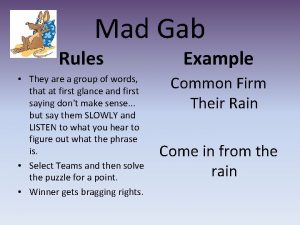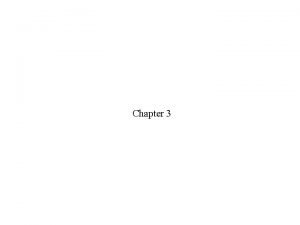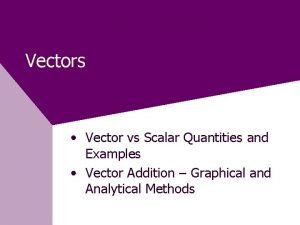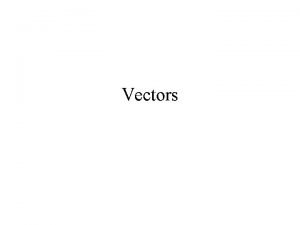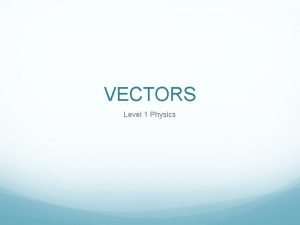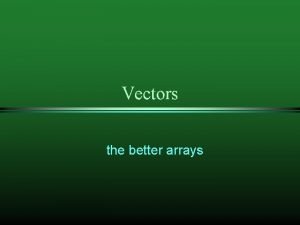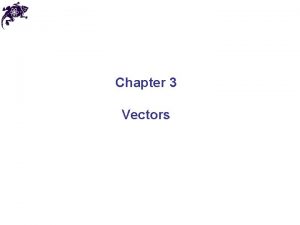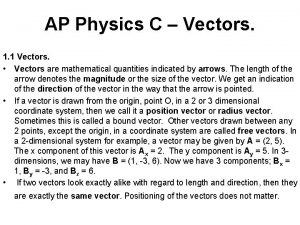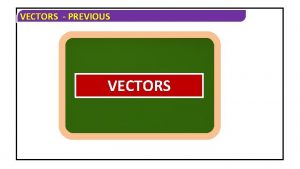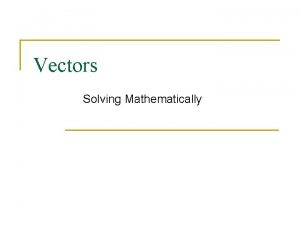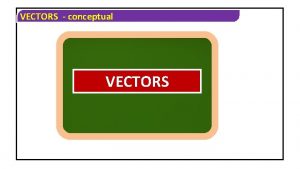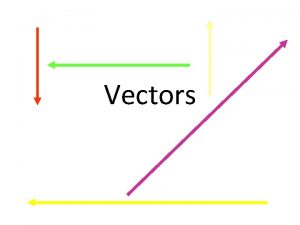Oh Yeah Vectors Aim What other details can





















- Slides: 21

Oh Yeah! Vectors Aim: What other details can be discussed about vectors?

How to Read Angles • Standard Position – The angle of COUNTERCLOCKWISE rotation starting from 0° to the vector (0° - 360°) • Reference Angle – The ACUTE angle between the vector and the (+ or -) x-axis • Compass Angle – [Angle] [Rotation] of [Start] “ 30° North of East” Rotation Direction Starting Direction

Example #1 90° N 60° 30° 0° E 180° W 270° S Standard 30° Reference 30° above the +x-axis Compass 1 30° North of East Compass 2 60° East of North

Example #2 90° N Standard 115° Reference 65° above the –x-axis Compass 1 25° West of North Compass 2 65° North of West 25° 65° 115° 0° E 180° W 270° S

Example #3 90° N 0° E 180° W 270° S Standard 270° Reference 90° below the x-axis Compass 1 South Compass 2 South

Example #4 90° N 315° 180° W 45° 0° E Standard 315° Reference 45° below the +x-axis Compass 1 45° South of East Compass 2 45° East of South 45° 270° S

Adding Vectors Tip-to-Tail When adding two or more vectors tip-to-tail you would typically REDRAW a vector so the TAIL of the NEXT vector connects to the TIP of the PREVIOUS vector. But there are some important rules to keep in mind 1. The vector’s length (magnitude) STAYS THE SAME 2. The vector’s orientation (direction) STAYS THE SAME 3. The RESULTANT VECTOR is the only vector that is drawn from the TAIL of the FIRST VECTOR to the TIP of the LAST VECTOR

Determine the Resultant Vector B A R A B Order doesn’t matter when adding vectors!

Determine the Resultant Vector B A R B

Determine the Resultant Vector B C A B C R

Equilibrant A special vector that is EQUAL in MAGNITUDE but faces the OPPOSITE DIRECTION (180°) of the resultant. Causes the system to reach EQUILIBRIUM, where the sum of all vectors is ZERO. Cancels out the resultant

Determine the Equilibrant Vector B A N E N , 20 B 20 N, SW

Determine the Resultant Vector B C 30 N @ 45° B C 30 N @ 225° A

Adding Vectors Algebraically 1. Determine the Horizontal and Vertical components of all the vectors 2. Add/Subtract ALL Horizontal Values (Direction Matters) – This will be the RESULTANT HORIZONTAL component 3. Add/Subtract ALL Vertical Values (Direction Matters) – This will be the RESULTANT VERTICAL component 4. Use Pythagorean Theorem to calculate the resultant MAGNITUDE 5. Use Trig to determine the resultant ANGLE (Direction)

Calculate the Resultant Vector 4 N 1 . 14 10 N @ 0° @ 4 5° 10 N @ 90° Horizontal Vertical Component A 0 N +10 N B +10 N 0 N R +10 N

Calculate the Resultant Vector ° s 40 -axi @ –x N 10 low be 20 N @ xis 9 7. 18 w –x-a lo ° be 10 N @ 180° Horizontal Vertical Component A -7. 66 N -6. 43 N B -10 N 0 N R -17. 66 N -6. 43 N

Calculate the Resultant Vector 30° @ 0 N 1 1. 74 N @ 55° below +x-axis ° 40 axis @ –x. N 10 low be Horizontal Vertical Component A -7. 66 N -6. 43 N B +8. 66 N 5 N R +1 N -1. 43 N

Maximum & Minimum Resultants • Calculating the MAXIMUM resultant requires two vectors to face the SAME DIRECTION. The angle between them must be 0°. (ADDITION) Max. Resultant • Calculating the MINIMUM resultant requires two vectors to face OPPOSITE DIRECTIONS. The angle between them must 180°. (SUBTRACTION) 180° Min. Resultant

Possible Resultants Possible resultants are in the RANGE between the minimum and maximum resultants. 7 N 10 N Min = 3 N Max = 17 N

Examples 1. Determine the minimum and maximum resultant between a 3 N force and a 5 N force A. 2 N – 8 N 2. Is it possible to have a resultant force of 25 N when a 5 N force and a 15 N force act concurrently on an object? A. No; 10 N – 20 N 3. Is it possible to have a resultant force of 15 N when a 5 N force and a 15 N force act concurrently on an object? A. Yes; 10 N – 20 N

SUMMARY • Describe the “Tip-to-Tail” Method of adding vectors • Describe the Algebraic Method of adding vectors • At what angle between two vectors will give you the maximum resultant? • At what angle between two vectors will give you the minimum resultant?
 Dont think about it just move your body
Dont think about it just move your body Minor and major supporting details
Minor and major supporting details Signal word
Signal word Ace nose dorm
Ace nose dorm Huh what is it good for absolutely nothing
Huh what is it good for absolutely nothing Yeah you made it
Yeah you made it Bickled
Bickled Yeah host
Yeah host Yeah but i do
Yeah but i do Yeah but i do
Yeah but i do Hare rama
Hare rama Ar verb conjugation
Ar verb conjugation Yeah diagram
Yeah diagram This chapter shows how vectors can be added using
This chapter shows how vectors can be added using Types of position
Types of position Cubing can help you gather details about a topic by
Cubing can help you gather details about a topic by Objects communicate with one another by using
Objects communicate with one another by using You cant have one without the other
You cant have one without the other /scriptimg srcx onerroralert1
/scriptimg srcx onerroralert1 Example of vector
Example of vector Representing vectors
Representing vectors Collinear vectors example
Collinear vectors example



